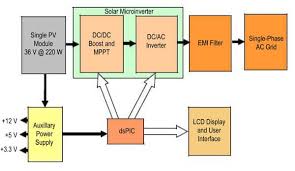Crafting a Comprehensive White Paper on Micro-Inverter Design and Development
Understanding the Scope
A comprehensive white paper on micro-inverter design and development should delve into various aspects, including:
- Fundamentals of Micro-Inverters:
- Definition and working principle
- Advantages over traditional string inverters
- Key components and their roles
- Power Electronics Topologies:
- Popular topologies (e.g., single-stage, two-stage)
- Comparative analysis of efficiency, cost, and complexity
- Design considerations for high-frequency operation
- Maximum Power Point Tracking (MPPT) Algorithms:
- Overview of MPPT techniques (e.g., Perturb and Observe, Incremental Conductance)
- Implementation challenges and optimization strategies
- Impact of shading and temperature on MPPT performance
- Grid-Interface and Safety Standards:
- Grid-code compliance and certification requirements
- Islanding prevention mechanisms
- Safety features and regulatory considerations
- Thermal Management:
- Heat dissipation techniques (e.g., heat sinks, fans, forced air cooling)
- Thermal modeling and simulation
- Impact of temperature on component reliability and efficiency
- Control Strategies:
- Digital signal processing (DSP) implementation
- Control algorithms for voltage and current regulation
- Fault detection and protection mechanisms
- Design and Development Tools:
- Simulation software (e.g., MATLAB/Simulink, PLECS)
- Hardware design tools (e.g., Altium Designer, OrCAD)
- Prototyping and testing methodologies
Compiling a Comprehensive Resource List
To create a truly comprehensive white paper, it's essential to reference relevant books, papers, and research groups. Here are some valuable resources:
Books:
- Power Electronics Converters by Ned Mohan
- Power Electronics: Converters, Applications, and Design by Mohan, Undeland, and Robbins
- Solar Energy Systems: Design, Analysis, and Applications by Richard C. Dorf
Research Papers:
- IEEE Transactions on Power Electronics
- IEEE Journal of Photovoltaics
- Solar Energy
- Applied Energy
Research Groups:
- Universities:
- Stanford University
- University of California, Berkeley
- University of Colorado Boulder
- National Renewable Energy Laboratory (NREL)
- Industries:
- SolarEdge
- Enphase Energy
- ABB
- Schneider Electric
Additional Tips for Creating a Comprehensive White Paper:
- Clear and Concise Writing: Use clear and concise language, avoiding technical jargon whenever possible.
- Visual Aids: Incorporate diagrams, flowcharts, and graphs to enhance understanding.
- Real-World Examples: Illustrate concepts with real-world examples and case studies.
- Future Trends: Discuss emerging technologies and future directions in micro-inverter design.
- Peer Review: Seek feedback from experts to improve the quality of the white paper.
By following these guidelines and leveraging the resources provided, you can create a comprehensive white paper that will be a valuable resource for researchers, engineers, and industry professionals alike.
Would you like me to delve deeper into any specific aspect of micro-inverter design and development? Or perhaps you'd like me to provide a more detailed outline for your white paper? contcat ias-research.com



